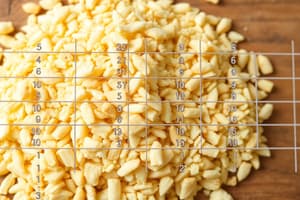Podcast
Questions and Answers
Match the proximate analysis component with its method of determination:
Match the proximate analysis component with its method of determination:
Moisture = Drying in an oven until constant weight Crude Protein = Determining nitrogen content and multiplying by 6.25 Ether Extract = Extraction with ether in a Soxhlet apparatus Ash = Burning in a muffle furnace at high temperature
Match the proximate analysis component with what it primarily measures:
Match the proximate analysis component with what it primarily measures:
Crude Fiber = Indigestible carbohydrate fraction, including cellulose and lignin Ether Extract = Fat content of the feed sample Nitrogen-Free Extract = Soluble carbohydrates, but also includes analytical errors Ash = Total mineral content
Match the limitation with the proximate analysis component it affects:
Match the limitation with the proximate analysis component it affects:
Nitrogen-Free Extract = Accumulates errors from other analyses Crude Protein = Overestimated due to non-protein nitrogen (NPN) Ether Extract = Includes non-nutritive compounds besides fats and oils Crude Fiber = Underestimates total fiber content due to loss of some components
Match the improvement/alternative with the component of proximate analysis it is designed to better represent:
Match the improvement/alternative with the component of proximate analysis it is designed to better represent:
Match the term with its corresponding definition within the context of proximate analysis:
Match the term with its corresponding definition within the context of proximate analysis:
Match the characteristic with the appropriate component determined in proximate analysis:
Match the characteristic with the appropriate component determined in proximate analysis:
Match the description with the correct method or analysis related to feed composition:
Match the description with the correct method or analysis related to feed composition:
Match the component with what the high result of the analysis could indicate:
Match the component with what the high result of the analysis could indicate:
Match the scenario with the appropriate adjustment or consideration in proximate analysis:
Match the scenario with the appropriate adjustment or consideration in proximate analysis:
Match the definition with the appropriate proximate analysis term:
Match the definition with the appropriate proximate analysis term:
Flashcards
Weende System (Proximate Analysis)
Weende System (Proximate Analysis)
A system to determine the nutritional composition of animal feed, separating components into moisture, crude protein, ether extract, crude fiber, ash, and nitrogen-free extract.
Moisture Determination
Moisture Determination
Determined by drying a sample in an oven until constant weight, the loss is recorded as moisture content.
Crude Protein (CP)
Crude Protein (CP)
Estimated by determining the nitrogen content of feed and multiplying it by 6.25, assuming all nitrogen comes from protein.
Ether Extract (EE)
Ether Extract (EE)
Signup and view all the flashcards
Crude Fiber (CF)
Crude Fiber (CF)
Signup and view all the flashcards
Ash
Ash
Signup and view all the flashcards
Nitrogen-Free Extract (NFE)
Nitrogen-Free Extract (NFE)
Signup and view all the flashcards
Van Soest Fiber Analysis
Van Soest Fiber Analysis
Signup and view all the flashcards
Amino Acid Analysis
Amino Acid Analysis
Signup and view all the flashcards
Near-Infrared Reflectance Spectroscopy (NIRS)
Near-Infrared Reflectance Spectroscopy (NIRS)
Signup and view all the flashcards
Study Notes
- The Weende system, also known as proximate analysis, determines the nutritional composition of animal feed.
- Wilhelm Henneberg and Friedrich Stohmann developed it in the mid-19th century at the Weende Experiment Station in Germany.
- The system separates feed components into six fractions: moisture, crude protein, ether extract, crude fiber, ash, and nitrogen-free extract.
- This wet chemistry procedure uses sequential extraction to isolate fractions.
- Despite its age and limitations, the Weende system remains a widely used and cost-effective method for feed analysis.
- It provides a basic understanding of the nutrient content of feedstuffs.
Components of Weende Analysis
- Moisture (Water): Determined by drying a sample in an oven until a constant weight is achieved, recording the loss in weight as moisture content.
- Crude Protein (CP): Estimated by determining the nitrogen content of the feed and multiplying it by a factor, typically 6.25.
- It assumes that all nitrogen in the feed comes from protein and that protein contains 16% nitrogen.
- CP = N x 6.25
- Ether Extract (EE): Measures the fat content of the feed.
- The dried sample is extracted with ether, and the material that dissolves in the ether is weighed as ether extract.
- Also known as crude fat.
- Crude Fiber (CF): Represents the indigestible carbohydrate fraction of the feed, consisting primarily of cellulose, hemicellulose, and lignin.
- The residue remaining after boiling the ether-extracted sample in dilute acid and then dilute alkali is designated as crude fiber.
- Ash: Determined by burning a sample in a furnace at high temperature (500-600°C) and weighing the residue, which represents the total mineral content.
- Nitrogen-Free Extract (NFE): Calculated by subtracting the sum of the percentages of moisture, CP, EE, CF, and ash from 100.
- NFE = 100 - (Moisture + CP + EE + CF + Ash)
- Represents the soluble carbohydrates such as sugars, starches, and some hemicelluloses.
- Also represents the errors in the analysis, and is the least accurate fraction.
Procedure
- Sample Preparation: The feed sample is first ground to a uniform particle size to ensure homogeneity.
- Moisture Determination: A known weight of the sample is dried in an oven at 100-105°C until a constant weight is achieved, and the loss in weight is recorded as moisture.
- Ether Extraction: The dried sample is then extracted with ether in a Soxhlet apparatus. The ether is evaporated, and the residue is weighed as crude fat (Ether Extract).
- Acid and Alkali Digestion: The ether-extracted sample is boiled in dilute acid and then in dilute alkali.
- Fiber Determination: The residue is dried, weighed, and then ashed in a furnace. The loss in weight due to ashing is recorded as crude fiber.
- Nitrogen Determination: A separate sample is used to determine the nitrogen content using the Kjeldahl method. The nitrogen content is multiplied by 6.25 to estimate crude protein.
- Ashing: Another sample is placed in a muffle furnace at 500-600°C until all organic matter is burned off, leaving behind the ash.
- NFE Calculation: NFE is calculated using the formula: NFE = 100 - (Moisture + CP + EE + CF + Ash).
Advantages
- Cost-Effective: Relatively inexpensive compared to more modern methods.
- Widely Available: Equipment and reagents are readily available in most laboratories.
- Standardized: The method is well-established and standardized, allowing for comparison of results across different laboratories.
- Provides Basic Information: Offers a basic understanding of the nutrient composition of feedstuffs.
Disadvantages
- Inaccuracy: The method is not very precise and can be subject to errors.
- Crude Estimates: Provides crude estimates of nutrient fractions rather than precise measurements.
- NFE Error: The calculation of NFE is subject to errors since it includes the cumulative errors from the other analyses.
- Incomplete Picture: Does not provide information on specific amino acids, fatty acids, vitamins, or minerals.
- Overestimation: Overestimates carbohydrate content because it includes other non-nitrogenous compounds.
- Nitrogen Assumption: Assumes all nitrogen comes from protein, which is not always accurate.
- Ignores Non-Nutritive Substances: Does not account for non-nutritive substances like tannins or alkaloids.
- Fiber Complexity: Crude fiber doesn't accurately represent total dietary fiber, as some fiber components are lost during the process.
- Environmental Impact: The use of ether and other solvents can pose environmental and safety concerns.
Limitations of Crude Protein
- The Kjeldahl method, used to determine nitrogen content and subsequently crude protein, does not differentiate between different forms of nitrogen.
- Non-protein nitrogen (NPN) sources, such as urea or ammonia, can inflate the crude protein value, even though they may not have the same nutritional value as true protein.
- The multiplication factor of 6.25 assumes that all proteins contain 16% nitrogen, which is not entirely accurate, as different proteins have varying nitrogen contents.
Limitations of Ether Extract
- Measures all substances soluble in ether, including fats, oils, waxes, pigments, and other non-nutritive compounds.
- It does not differentiate between different types of lipids, such as saturated, unsaturated, or essential fatty acids.
Limitations of Crude Fiber
- Underestimates the total fiber content of feedstuffs because some fiber components, such as hemicellulose and lignin, are partially lost during the acid and alkali digestion steps.
- It does not provide information on the specific types of fiber present, such as soluble or insoluble fiber.
Limitations of Ash
- Represents the total mineral content of the feed but does not provide information on the specific minerals present or their bioavailability.
- Some minerals may be lost during the ashing process due to volatilization.
Improvements / Alternatives
- Van Soest Fiber Analysis: Provides a more accurate determination of fiber fractions, including neutral detergent fiber (NDF) and acid detergent fiber (ADF).
- NDF represents the total fiber content.
- ADF represents the cellulose and lignin content.
- Amino Acid Analysis: Determines the specific amino acid composition of feedstuffs, providing a more accurate assessment of protein quality.
- Gas Chromatography: Determines the fatty acid profile of feedstuffs, providing information on the types and amounts of different fatty acids.
- Inductively Coupled Plasma (ICP) Spectroscopy: Determines the mineral composition of feedstuffs, providing information on the types and amounts of different minerals.
- Near-Infrared Reflectance Spectroscopy (NIRS): A rapid and non-destructive method for analyzing the chemical composition of feedstuffs.
- NIRS uses infrared light to scan the sample and measures the reflected light.
- The data is then used to predict the nutrient content of the sample.
Studying That Suits You
Use AI to generate personalized quizzes and flashcards to suit your learning preferences.



